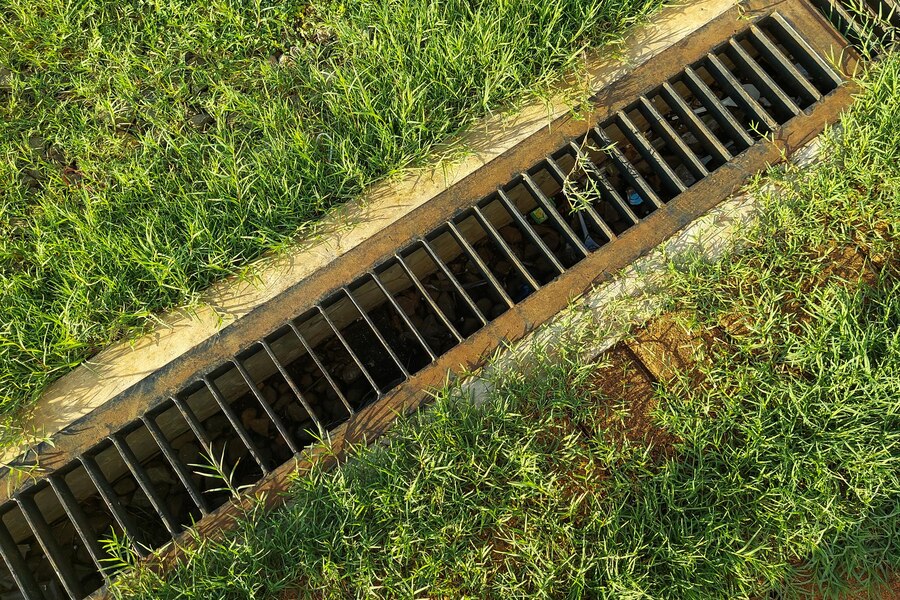%201%20(1).webp)
%201%20(1).webp)

The Importance of Quality Pavement Maintenance


Common Landscape Drainage Problems in Delaware Residential Properties
For homeowners in Delaware, keeping a yard in good shape involves more than regular mowing or trimming. One of the biggest problems residents face is poor drainage. If rainwater or melted snow can’t properly flow away from your property, it can lead to soggy lawns, foundation issues, and even long-term damage to the driveway, walkway, or patio. Staying ahead of drainage problems is a key part of smart landscape maintenance in Delaware.
When these drainage issues build up, they don’t just affect how your yard looks. They can also cause muddy patches that make mowing harder, damage to fence posts, and erosion that uproots plants or shifts soil. To protect both the appearance and stability of your outdoor space, it helps to understand what causes the most common drainage problems and what can be done to fix them.
Poor Grading Can Send Water Where It Shouldn’t Go
When a lawn or yard is poorly graded, water ends up flowing toward the house instead of away from it. The grading of your yard refers to how the ground slopes. If the surface isn’t angled correctly, rainwater has nowhere to drain and will collect in low areas. In most cases, this happens because of how the house was originally built or because the soil has settled unevenly over time.
Common signs of poor grading include:
- Water pooling near the home’s foundation
- Swampy or soggy spots in the middle of the yard
- Mulch and soil washing away during heavy rain
- Overflow from flower beds or turf areas
These symptoms usually show up slowly, but once they do, they tend to get worse with each storm. Once the soil becomes oversaturated, it can lead to plant rot and lawn disease. If the water starts pressing against foundations or seeping into crawl spaces, it can cause structural concerns.
Fixing poor grading usually calls for reshaping the yard to guide water to the right places. This might mean building up soil in certain areas or gently lowering parts of the yard to create a smooth slope that leads away from buildings. In more severe situations, a yard may need a full drainage correction plan that includes professional regrading and installation of drainage tools like swales or buried piping systems.
If you notice rain sitting in one spot for more than a few hours or if areas around your exterior walls stay soft or wet days after every rain, it may point to a grading issue that needs expert attention.
Clogged Gutters and Downspouts Block Water Flow
It’s easy to forget about what’s happening above eye level, but problem gutters play a big role in poor yard drainage. When gutters and downspouts get clogged, water that should be directed far away from the house ends up pouring out along the roofline. This overflow quickly turns into soil erosion, ruined landscaping, or even damage to siding and trim.
Some of the most common issues that cause blockages include:
- Fallen leaves and roof debris filling up gutters
- Bird nests or rodent activity near downspout areas
- Improperly installed or undersized downspouts
- Downspouts that direct water too close to the house
When water exits the gutter system and lands right next to your home, it increases the chance of basement leaks and ground-level flooding. Even if the water doesn't get indoors, oversaturation can overwhelm flower beds and make it harder for grass to grow.
To prevent these issues, homeowners should follow a regular gutter cleaning schedule. In most cases, this means checking and clearing out gutters twice per year, more often if the property has nearby trees. During this maintenance, make sure downspouts are directing water at least several feet away from the home's foundation. You can also install splash blocks or extensions to make sure water doesn't re-enter the soil near the structure.
Maintaining an open and functioning drainage path via the gutter system is a simple way to avoid larger drainage problems in the yard. If clogs aren’t addressed, even a modest rainfall can create backyard flooding issues that could have been prevented with seasonal upkeep.
Insufficient Drainage Systems Fail to Move Water Away
Some properties in Delaware show all the signs of too much groundwater, but the yard might already have some sort of drainage system in place. The issue could be that the system is outdated, overloaded, or just wasn’t designed well for current conditions. Improper placement, shallow installation, or blocked pipes often cause otherwise good systems to stop working the way they should.
Signs your property might be dealing with an underperforming or missing drainage system include:
- Persistent standing water even after moderate rain
- Pooling near downspouts or patio edges
- Soggy flower beds despite dry weather
- Driveway or walkway cracking from ongoing subsurface moisture
If the soil is constantly waterlogged, grass won’t grow well and tree roots may start to rot. Driveways and concrete walkways can shift, sink, or crack as water slowly erodes the base underneath. For homeowners who built patios or added landscaping features over the years, their property layout may no longer support proper runoff.
In many cases, trench drains, French drains, or dry wells are used to collect and carry water away from problem spots. Deck drains and catch basins are also helpful in high-traffic areas or around foundations. The right system depends on the land's slope, soil conditions, and layout of features such as hardscaped areas. Drainage installation isn’t just about picking a product. It's about making it work with how the entire property drains during different types of rain.
Our professionals can review your property and determine where water is getting stuck or redirected. From there, a properly built system can keep moisture under control before it harms landscaping or paved surfaces.
Soil Erosion and Compaction Change Water Behavior
For residents in Delaware, another overlooked drainage concern sits right beneath the surface. Soil that's been damaged by erosion or compacted due to heavy traffic becomes a major source of water flow issues. These soil conditions affect how quickly water is absorbed into the ground or how far it spreads across the surface.
Soil erosion usually occurs on slopes or along paths where water flows quickly during storms. It will strip away topsoil, expose roots, and leave channels or ditches. On the flip side, compacted soil, often the result of frequent foot traffic, lawn equipment, or vehicles, gets so tightly packed that water can't filter into the ground at all.
Both conditions can leave a yard looking patchy and uneven. Water might rush to the lowest point of your property or just pool on top of the surface with nowhere to go.
Ways to address and prevent soil erosion and compaction include:
- Installing ground cover or mulch in exposed areas
- Aerating compacted soil to improve permeability
- Adding organic matter to help soil retain structure
- Redirecting water away from foot paths or bare patches
- Stabilizing slopes with low-maintenance native plants
If unchecked, these issues can make your yard harder to maintain, limit plant growth, and contribute to long-term drainage failure. Addressing soil condition isn't just about landscaping quality. It plays a real role in how water behaves on your property.
Maintaining a Healthy Landscape Through Drainage Control
When drainage issues are left alone, they don’t just make your yard look messy. They can impact your home's foundation, hardscaping elements, and even your interior spaces over time. The longer moisture problems go unaddressed, the more expensive and complicated they become. That’s why spotting early warning signs like soggy patches, eroded soil, or recurring gutter overflow makes a big difference.
Regular inspections help catch potential drainage issues before they cause serious damage. Whether it’s checking gutter outlets, looking for uneven grading, or monitoring how quickly water clears after rain, getting ahead of problems can save you time and money. During the warmer months, it’s a good time to handle any drainage upgrades or repairs, since soil tends to be more workable and observation is easier.
A well-maintained yard does more than boost appearance. It protects your home’s foundation, prevents landscape damage, and supports strong plant health. With proper drainage, Delaware homeowners can spend more time enjoying their outdoor space and less time dealing with soggy lawns, cracked paths, and worn-out soil. Keeping everything working as it should takes proper planning, the right tools, and help from the right professionals.
If you're ready to keep your yard in shape and prevent drainage issues from turning into costly problems, Professional Pavement Services offers expert support for effective landscape maintenance in Delaware to help you achieve lasting results. For a quick estimate or to book a service visit, please contact us today.
Recent Posts

Join Our Community of Readers
Stay updated with our latest insights and share your thoughts with us in the comments!


.svg)












.png)




